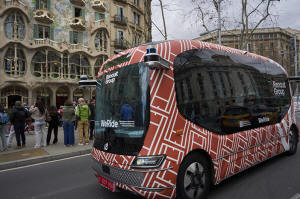Driverless 'bus of the future' is tested in Barcelona
[March 15, 2025] By
HERNAN MUÑOZ and JOSEPH WILSON
BARCELONA, Spain (AP) — Commuters in downtown Barcelona have been able
to ride the bus for free this week. There’s just one catch: this
mini-bus has no one at the wheel.
The bus pulls away from the stop with its passengers on its own, brakes
before changing lanes and eases down one of Barcelona’s most fashionable
boulevards.
Renault is testing a new driverless mini-bus in Barcelona this week. The
autonomous vehicle is running on a 2.2-km (1.3-mile) circular route with
four stops in the center of the Spanish city. Adventurous commuters can
jump on free of charge.
The French carmaker has teamed up with WeRide, a company specializing in
autonomous vehicles, to make the prototype. It unveiled the driverless
bus at the French Open venue last year, but now it is testing it on the
open road in Barcelona. It also has testing projects going in Valence,
France, and at the Zurich airport.
Pau Cugat was one of the curious to step aboard for a short ride along
Passeig de Gracia boulevard.
“We just passed by a regular, combustion-engine city bus, and I thought,
‘Look, there is a bus of the past, and right behind it you have the bus
of the future,’” the 18-year-old student said.

Driverless taxis and buses are being tried out by companies in other
cities, from San Francisco to Tokyo.
But Renault’s initiative comes as Europe generally lags behind the
United States and China in driverless vehicle technology, where
companies are fiercely competing to get ahead.

[to top of second column] |

A driverless mini-bus, presented by WeRide and Renault Group, drives
by Casa Batlló, designed by Antoni Gaudí, in Barcelona downtown,
Wednesday, March 12, 2025. (AP Photo/Emilio Morenatti)
 “The US is doing a lot of
experimentation with autonomous vehicles, the same thing in China,”
Patrick Vergelas, head of Renault's autonomous mobility projects,
told The Associated Press. “Until now we don’t have a lot in fact in
Europe. And this is why we want to show that this works and prepare
Europe to this route in public transportation.”
The electric bus can run for 120 kilometers without a recharge and
reach 40 kilometers per hour (25 mph). It is equipped with 10
cameras and eight lidars (sensor arrays) to help it navigate the
streets filled with cars, motorbikes and pedestrians. The company
says the bus is able to drive safely on a given course through a
busy downtown like that of bustling Barcelona.
Carlos Santos, of Renault’s autonomous driving group, said that he
has seen all types of reactions from riders.
“We’ve seen a lot of behaviors of people. Some of them were smiling,
(while) other people just start crying, taking photographs or even
try to open the doors," Santos said before he insisted that the bus
ride was a safe one.
Barcelona's city officials said that they have had no reports of
accidents caused by the experimental bus.
All contents © copyright 2025 Associated Press. All rights reserved |